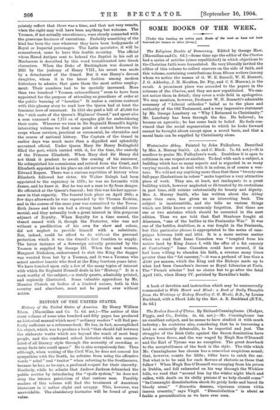Westminster Abbey. Painted by John Fulleylove. Described by Mrs. A.
Murray Smith. (A. and C. Black. 7s. 6d. net.)—It is needless to praise Mr. Fulleylove's work. Doubtless it is open to criticism in one respect or another. To deal with such a subject, a building which has so many aspects and is regarded in so many varying moods, and to deal with it in colour, is of course a ven- ture. We will not say anything more than that these "twenty-one full-page illustrations in colour" make together a very attractive piece of work. They are, at least, not inadequate to a great building which, however neglected or ill-treated by its custodians in past time, still retains substantially its beauty and dignity. Mrs. A. Murray Smith, who has written about the Abbey more than once, has given us an interesting book. The subject is inexhaustible, and she tells us various things which are little known or commonly forgotten. But there are one or two mistakes which should be corrected in the next edition. Thus we are told that Earl Stanhope fought at Almenara, "one of the battles in the Peninsular War." It was one of the battles, doubtless, in a war fought in the Peninsula, but this particular phrase is appropriated to the series of cam- paigns between 1808 and 1814. It is a more serious matter when we read that Isaac Casaitbon was "tempted from his native land by King James I. with the offer of a fat canonry at Canterbury." Isaac Casaubon could have secured, if he had been willing to abandon his faith, a revenue many times greater than the "fat canonry,"—it was a prebend of less than a .2100 per annum, which the King and the Bishops made up to what had been Casaubon's income as Royal Librarian at Paris. The "French scholar" had no choice but to go after the fatal April 14th, when Henry IV. perished by Ravaillac's knife.


































 Previous page
Previous page